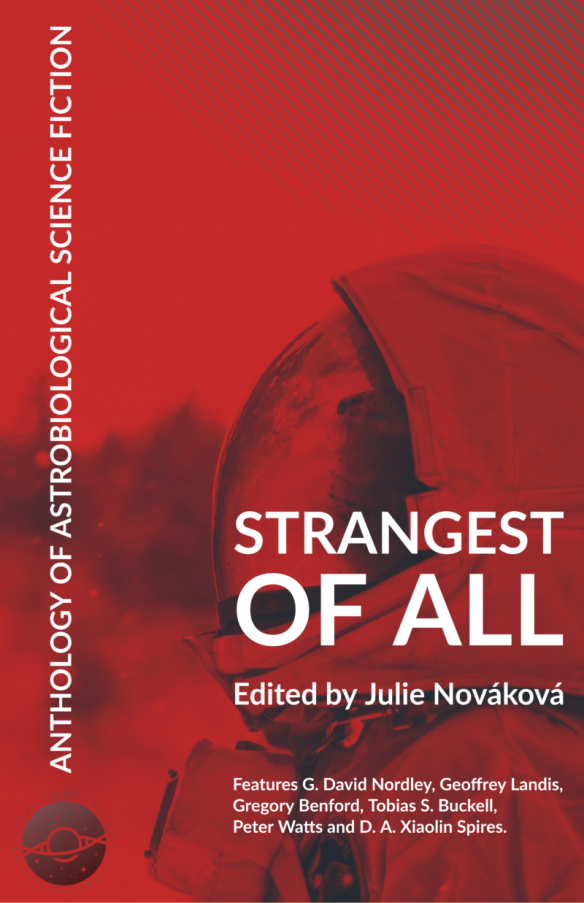
Strangest of All, an anthology of astrobiological science fiction, edited by Julie Nováková, is now available as a free download. The book was created for the European Astrobiology Institute’s BEACON 2020 conference, cancelled because of the coronavirus outbreak.
The collected stories take readers on a journey to encounter life in the universe. The original nonfiction essays following each story consider our chances of finding life outside of the Earth, detecting it remotely, and learning its limits.
The stories are reprints by G. David Nordley, Geoffrey Landis, Gregory Benford, Tobias S. Buckell, Peter Watts and D. A. Xiaolin Spires, plus a bonus story by the editor.
DOWNLOAD. The anthology can be downloaded as a .pdf file here. It is also available as a .mobi and .epub file.

EUROPEAN ASTROBIOLOGY INSTITUTE. By fostering interdisciplinary and international research in astrobiology and bringing together scientists, industry and the general public, the EAI aims to educate and to present the exciting and relevant field of astrobiology.
One of the ways to introduce astrobiology to people of various ages, backgrounds, nations or interests is through popular fiction. Science fiction has long served as means to showcase new ideas, has always been inspired by science and vice versa. That’s why EAI developed a project team “Science Fiction as a tool for Astrobiology Outreach and Education”, whose first major project is the educational and outreach astrobiological SF anthology Strangest of All.
Do you have a passion for science, outreach/education and science fiction and would like to be involved in similar projects? Get in touch with the editor at [email protected].
ABOUT THE STORIES. Nordley’s “War, Ice, Egg, Universe” takes readers to an aquatic civilization inhabiting a Europalike world with an ice-covered ocean, and the accompanying essay focuses on what we know about conditions for life on Europa, Enceladus, Ganymede and other ocean worlds.
In “Into The Blue Abyss” by Landis, the protagonist dives into an entirely different ocean – the high-pressure liquid water layer on Uranus, where chemistry signifying possible life had been observed. Could life really exist in such conditions – and could high-pressure environments actually be one of the most common habitats in the universe?
Continuing the journey outward of the Sun, “Backscatter” by Benford finds life in an improbable place: an icy asteroid in the Kuiper Belt. The follow-up essay provides background on the possibility of life in asteroids and comets, and dives into the topic of exotic silicon-based life in such cold places with no liquid water.
In Buckell’s “A Jar of Goodwill”, we leave solar system and environments similar to it entirely, visiting a strange exoplanet where plants metabolize chlorine – but the main problem the hero faces is whether its ant-like inhabitants are intelligent creatures. Halogen-based photosynthesis was actually proposed in theory – so we can look at where we could expect such exotic life.
Even more exotic is the titular creature in Watts’ novelette “The Island”: a live Dyson sphere. In the essay, we look at how we can search for Dyson spheres, what the surveys yielded up-to-date, and whether we could presume anything about the origin and thought processes of a nigh impossible being like the Island.
Benford returns with a microstory “SETI for Profit”, an interesting take on how to revive interest in SETI. What efforts to listen to potential extra-terrestrial messages have been taken so far, and what can we expect in the future?
The topic of SETI is inextricably linked with the Fermi Paradox, one of the themes of Spires’ “But, Still, I Smile”. How can we explain the paradox with what we know so far, and how does the explanation in the story relate to our world?
Finally, in the bonus story by Nováková, “Martian Fever”, we look at Mars exploration gone awry – and the risks of interplanetary biological contamination and the question of planetary protection.
Each story is followed not only by the science essay complete with references for readers craving more, but also a couple of ideas for classroom discussions or tasks (best-suited for higher high school grades or undergraduate university students), such as thinking of how to devise a message for a potentially listening alien civilization, bearing in mind what we know of sensory and cognitive differences between species here on Earth. For most of the questions, there is no definitive answer – but all the more curiosity should they elicit.
[Thanks to Gregory Benford and Nina Shepardson for the story. Based on a press release.]
